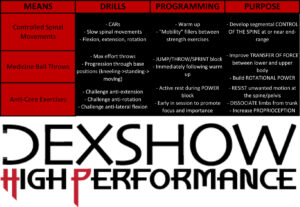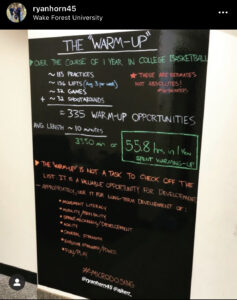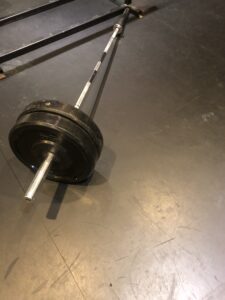Last week, a goalie coach I know and respect posted this:

I vehemently disagree with the post for a few reasons and I reached out to him to let him know why I’m opposed to fearmongering in parents and perpetuating outdated myths when it comes to youth training. His response was “agree to disagree.” What irked me the most was:
“#parents We all know weight training isn’t recommended for younger goalies.”
There’s a lot built into this short sentence, so let’s break it down. First, using the hashtag #parents is an attempt to gain more traction to the audience who make the decisions for youth. I’m a parent and I want the absolute best for my two boys and if I didn’t know any better, I’d take this post for truth since I respect him as a goalie coach. That’s manipulation. Next, the post uses the logical fallacy of APPEAL TO MAJORITY – by stating “We all know…” it implies that because people think this is true, then it must be correct. It’s not, and research and anecdotal evidence suggest otherwise but we’ll get to that later. Finally, using broad and vague language, like “younger goalies,” isn’t concise and leaves a HUGE range of what that means. Younger than who? Younger than 40? Younger than 10? When concerning youth, it’s better to be specific and not paint with a wide brush.
With that, I wanted to take the opportunity to educate parents as much as I could on why this post is incorrect and potentially harmful for overall youth development. For the sake of continuity in language, when I use the word “YOUTH” I am referring to pre- and mid-pubescent kids ages 12 and older. I’ll break the article up into three separate posts that I hope will address some of the persistent, negative myths about weight training for youth including:
- IS LIFTING WEIGHTS SAFE FOR YOUTH ATHLETES?
- WHY SHOULD MY CHILD LIFT WEIGHTS/TRAIN?
- HOW CAN MY KID TRAIN SAFELY AND EFFECTIVELY?
I hope to provide clarification on these points and help parents make more educated decisions for their kids when it comes to sports, training, and – most importantly – LONG TERM ATHLETIC DEVELOPMENT (LTAD). Let’s jump right in to Part I:
IS LIFTING WEIGHTS SAFE FOR YOUTH (ATHLETES)?
In this day and age of youth sports, athletics, research, and technology, the answer is a resounding YES. There are some caveats though, so let’s be aware of that – I’ll address them in Part III of this article. Did you know that kids are exposed to forces 4-6x their own bodyweight in ground reaction forces EVERY STEP when they are running and sprinting? The same goes for when they’re jumping. That’s right, a 50lbs child is mitigating up to 300lbs of force EVERY STEP as they’re running and leaping around the playground with their friends but we don’t perpetuate a myth that running is dangerous for kids – in fact, we want our kids to run and play! And so we should. Here is an excerpt from an Eric Cressey article from 2009:
"Kids jump out of trees all the time. They lug around insanely heavy backpacks relative to their body mass. Performance, general health, and self-esteem benefits aside, it's only right to give them a fighting chance in trying to avoid injury."
Eric Cressey Tweet
Gait/locomotion is an essential part of human development but it’s also essential for Long Term Athletic Development: walking is good, running is better, and running fast and jumping high is great when it comes to LTAD. Kids are going to do all of that stuff anyway, we might as well give them the prerequisite strength to be able to carry their backpacks and play sports safely. Furthermore, exercise helps to increase bone density, increase strength, lower incidence of obesity, and improve pretty much all health markers, youth included.
What’s troubling though is saying that weight training is dangerous for youth. Really? Kids encounter massive forces through life and play EVERY DAY that are FAR GREATER than any load they would ever touch in a gym or weight room. Here is a video of my 4-year-old son jumping off of a 24-inch box onto rubber flooring. He’s absorbing a LOT of force (gravity acting on his body mass) when he hits the ground – a lot more than any sane person would ask him to lift if he was weight training – so how is one encouraged and the other frowned upon?
Want to know another arena where youth are exposed to car wreck-type forces? SPORTS. 12-year-olds having multiple helmet on helmet collisions weekly playing football? “No problem, sports are great for kids.” 12-year-olds lifting weights in a safe and controlled environment? “Hazard. Too dangerous for my kid.” Can you see the problem with this thought process? When it comes down to it, the two biggest misconceptions and/or myths when it comes to the “dangers” of youth weightlifting/resistance training are:
- Lifting weights is dangerous for youth because it will damage their growth plates
- Lifting weights stunts the growth of youth and doesn’t allow for them to fully develop physically
These points almost seem to be cause and effect reasoning: “Lifting weights is dangerous for youth because it will damage their growth plates which stunts growth and physical development.” I’ll be the first to admit that lifting weights has some inherent risk of injury, especially when performed incorrectly with poor form, using loads that are too high, or when instructed by unqualified individuals. That goes for youth, teenagers, middle aged adults, and geriatrics though. Nobody can get away lifting like an idiot for any sustained amount of time without paying the price. Playing sports also comes with inherent injury risk – significantly higher than weight training in every study that I found…by a lot. So there’s that.
Let’s discuss growth plates and growth plate injuries. As children age and physically develop, their bones start to mature and become fully formed, skeletal bone. What is important to consider about growth plates in humans is that all of our bones DO NOT mature at the same rate. Some growth plates fuse at 10 years old (lower arm), while some aren’t fully developed until the ripe old age of up to 25 (clavicle, scapula)! If the myth of holding youth out of weight training is due to their bones being unformed, we must consider keeping even pro athletes away from lifting until they are 25 years old! It doesn’t make any sense. Growth plate injuries do occur in youth, but they are almost exclusively seen in acute trauma (falls from trees, slips, etc.) or repetitive, high velocity sporting actions like throwing a baseball.
With the extremely unlikely chance of growth plate injuries during youth weightlifting, the stunting of growth myth likely disappears. Anecdotally, plenty of high level, vastly experienced strength coaches like Mike Boyle (who’s been training youth for 30+ years) seem to think that consistent strength training from 12-years-old and up may actually INCREASE GROWTH AND PHYSICAL DEVELOPMENT. The science seems to agree that weightlifting can positively impact bone development in terms of bone mineral density (Conroy, Kraemer, et. al., 1993), decreasing fracture risk, and at the very least “do(es) not negatively impact growth and maturation of pre- and early-pubertal youth.” (Malina, 1996).
With these misguided claims and inaccurate myths put to rest, we will look at some of the reasons WHY it is important for youth to weightlift in Part II. I’ll even contend that strength training is an essential piece of Long Term Athletic Development for youth athletes and can be the missing link for kids who deal with chronic overuse injuries, joint pain, and mental burnout from the outrageous youth sports culture of today. Stay tuned.
Get strong, stay strong.
Coach Dex



